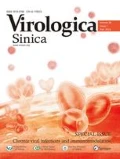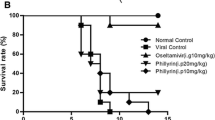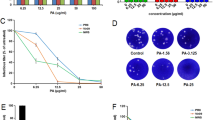Abstract
In order to evaluate the anti-influenza virus activity of the effective monomer from Folium Isatidis (FI) in vivo, we established mice model with viral pneumonia and divided them into 3 different dose groups, then observed their lung indexes, pulmonary pathological changes, pulmonary virus hemagglitination titers, living time and death rates. The results showed that the monomer could reduce the pulmonary index from 2.64 to 1.93, 1.63 and 1.40 (P<0.01) and decrease the hemagglitination titer from 1.15 to 0.84, 0.70 and 0.59 (P<0.01). In addition, different groups of FI could significantly lessen the mortality rate from 100% to 30%, 25% and 15%, and prolong the living time from 5.1d to 6.5d, 8.4d and 8.9d respectively(P<0.01). The high dose (75 mg/kg/d) has the similar effect with 100 mg/kg/d dose of virazole(P>0.05), and more effective than 200 mg/kg/d dose of antiviral liquor (P<0.05).
Similar content being viewed by others
References
Barr I G, Hurt A C, Deed N,et al. 2007a. The emergence of adamantane resistance in influenza A (H1) viruses in Australia and regionally in 2006. Antiviral Res, 75: 173–176.
Barr I G, Hurt A C, Iannello P,et al. 2007b. Increased adamantane resistance in influenza A (H3) viruses in Australia and neighbouring countries in 2005. Antiviral Res, 73: 112–117.
Bright R A, Medina M J, Xu X,et al. 2005. Incidence of adamantane resistance among influenza A (H3N2) viruses isolated worldwide from 1994 to 2005: a cause for concern. Lancet, 366: 1175–1181.
Bright R A, Shay D K, Shu B,et al. 2006. Adamantane resistance among influenzaAviruses isolated early during the 2005–2006 influenza season in the United States. JAMA, 295: 891–894.
Cheung C L, Rayner J M, Smith G J,et al. 2006. Distribution of amantadine-resistant H5N1 avian influenza variants in Asia. J Infect Dis, 193: 1626–1629.
Deyde V M, Okomo-Adhiambo M, Sheu T G,et al. 2009. Pyrosequencing as a tool to detect molecular markers of resistance to neuraminidase inhibitors in seasonal influenza A viruses. Antivir Res, 81: 16–24.
Garman E, Laver G. 2004. Controlling influenza by inhibiting the virus’s neu-raminidase. Curr Drug Targets, 5: 119–136.
Hayden F G, Hay A J. 1992. Emergence and transmission of influenza A viruses resistant to amantadine and rimantadine. Curr Top Microbiol Immunol, 176: 119–130.
Hayden F, Klimov A, Tashiro M,et al. 2005. Neuraminidase inhibitor susceptibility network position statement: antiviral resistance in influenza A/H5N1 viruses. Antiviral Ther, 10: 873–877.
Ilyushina N A, Govorkova E A, Webster R G. 2005. Detection of amantadine-resistant variants among avian influenza viruses isolated in North America and Asia. Virology, 341: 102–106.
Puthavathana P, Auewarakul P, Charoenying P C,et al. 2005. Molecular characterization of the complete genome of human influenza H5N1virus isolates from Thailand. J Gen Virol, 86: 423–433
Palese P. 2004. Influenza: old and new threats. Nat Med, 10: S82–S87.
Saito R, Li D, Suzuki Y,et al. 2007. High prevalence of amantadine-resistance influenza A (H3N2) in six prefectures, Japan, in the 2005–2006 season. J Med Virol, 79: 1569–1576.
Sheu T G, Deyde V M, Okomo-Adhiambo M,et al. 2008. Surveillance for neuraminidase inhibitor resistance among human influenza A and B viruses circulating worldwide from 2004–2008. Antimicrob Agents Chemother, 52: 3284–3292.
Shiraishi K, Mitamura K, Sakai-Tagawa Y,et al. 2003. High frequency of resistant viruses harboring different muta-tions in amantadine-treated children with influenza. J Infect Dis, 188: 57–61.
Wutzler P, Kossow K D, Lode H,et al. 2004. Antiviral treatment and prophylaxis of influenza in primary care: German recommenda-tions. J Clin Virol, 31: 84–91.
Author information
Authors and Affiliations
Corresponding author
Additional information
Foundation item: Natural Science Foundation of South Central University for Nationalities (YZQ05011)
Rights and permissions
About this article
Cite this article
Liu, Z., Yang, Zq. & Xiao, H. Antiviral activity of the effective monomers from folium isatidis against influenza virus in vivo. Virol. Sin. 25, 445–451 (2010). https://doi.org/10.1007/s12250-010-3142-0
Received:
Accepted:
Published:
Issue Date:
DOI: https://doi.org/10.1007/s12250-010-3142-0




